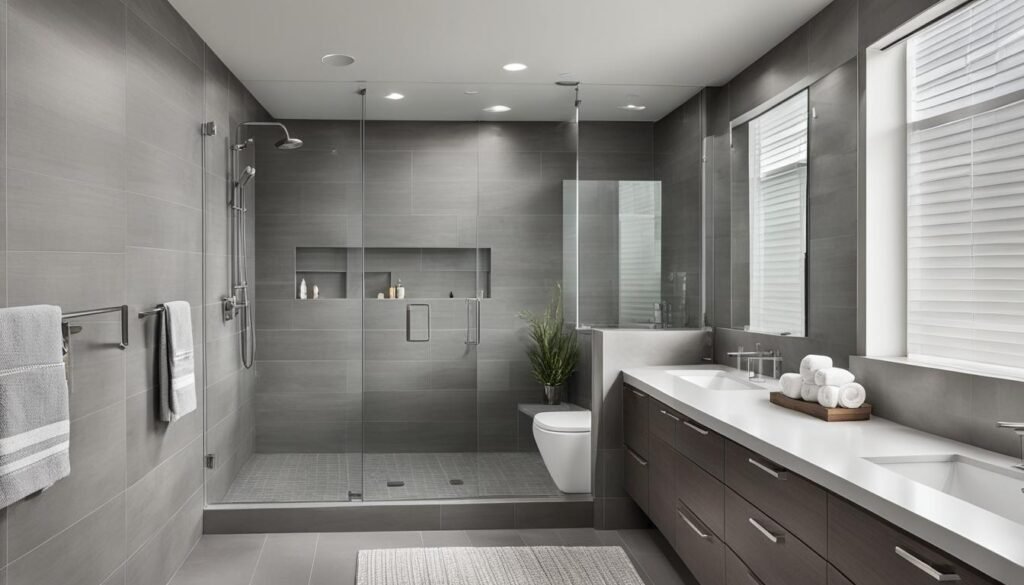Welcome to our comprehensive guide to home improvement. Whether you’re considering a DIY home renovation, seeking remodeling ideas, or looking for interior design tips, this article has you covered. We’ll also explore outdoor landscaping projects, provide advice on finding reliable home improvement contractors, and share insights on sustainable and energy-efficient upgrades. Get ready to transform your home into a stylish and functional space that you’ll love coming back to.
Key Takeaways
- Gain inspiration and practical advice for various home improvement projects.
- Have a clear vision for your home’s design and find budget-friendly ways to achieve it.
- Seal gaps and install water-saving fixtures to enhance energy efficiency.
- Maintain your home’s downspouts to prevent water damage and leaks.
- Incorporate fresh flowers into your interior design for a vibrant and welcoming space.
Have a Vision for Your Finished Product
When embarking on a home improvement project, one of the key elements for success is having a clear vision for your finished product. Whether it’s a small room renovation or a complete home makeover, a unified vision will guide you throughout the process and ensure that all the rooms and materials work together harmoniously.
Creating a unified home design is essential to achieve a cohesive and aesthetically pleasing space. Consider the overall style and theme you want to achieve for your home. This will help you make decisions on color schemes, furniture, and decor that complement each other and create a seamless flow from room to room.
It is also important to take budget into account when creating your vision. Home improvements can quickly become expensive, but there are many budget-friendly tips and tricks to help you achieve your desired look without breaking the bank. From repurposing furniture to shopping at thrift stores for unique decor pieces, there are plenty of ways to stay within your budget while creating a beautiful home.
Creating a Unified Home Design
A unified home design means that each element in your home works together to create a cohesive look. This includes the color scheme, furniture styles, textures, and overall aesthetic. By having a unified vision, you can ensure that your home feels inviting and visually appealing.
Start by choosing a color palette that flows throughout your home. This doesn’t mean every room has to be the same color, but there should be a common thread that ties them together. Consider using neutral colors as a base and adding pops of color through accessories and accent walls.
Another way to create unity in your home design is to choose complementary furniture styles. Mixing and matching different styles can create an eclectic look, but be mindful of how they work together. For example, if you have a modern sofa, pairing it with antique side tables may create a disjointed look. Instead, opt for furniture pieces that share similar design elements or materials.
Lastly, pay attention to the textures and materials used in your home. Mixing textures such as smooth surfaces, rough textures, and various fabric types adds visual interest and depth. Consider incorporating natural materials like wood or stone for a touch of warmth and organic appeal.
By having a vision for your finished product and considering both the design elements and your budget, you can create a beautiful and unified home that reflects your personal style. So, set your goals, gather inspiration, and get ready to transform your space into the home of your dreams.
Seal Gaps and Install Water-Saving Fixtures
When it comes to home improvement, ensuring that your house is well-maintained and energy-efficient is essential. One often overlooked aspect is sealing gaps between baseboards and walls. These tiny spaces can lead to drafts and energy loss, impacting the overall efficiency of your home.
By taking the time to seal these gaps, you can better regulate the temperature in your home and reduce your energy consumption. Not only will this help you save on utility costs, but it also contributes to a more sustainable lifestyle.
Another effective way to make your home more energy-efficient is by installing water-saving fixtures. Upgrading to water-saving faucets and showerheads can significantly reduce water consumption without compromising on performance. These fixtures are designed to minimize water flow while still providing satisfactory water pressure.
By conserving water, not only are you reducing your utility bills, but you are also making an eco-friendly choice that benefits the environment. Conserving water helps preserve this precious resource and can have a positive impact on your community and the planet.
Sealing Gaps: Protecting Your Home and Saving Energy
Sealing gaps between baseboards and walls is an effective way to protect your home from drafts and energy loss. These gaps can be a common source of air leakage, allowing outside air to enter your home and conditioned air to escape. By properly sealing these gaps, you can create a more comfortable living environment and reduce your energy bills.
There are several options available when it comes to sealing gaps. One popular choice is using caulk, which can be applied to the cracks and crevices to create an airtight seal. Another option is weatherstripping, which is typically used for larger gaps. Weatherstripping materials can be applied to doors and windows to prevent air leakage.
It is important to thoroughly inspect your home for any gaps that may need sealing. Pay close attention to areas where different building materials meet, such as baseboards, window frames, and door frames. By identifying and sealing these gaps, you can effectively reduce energy loss and create a more energy-efficient home.
Water-Saving Fixtures: Efficiency without Sacrificing Performance
Installing water-saving fixtures is an excellent investment in both your wallet and the environment. These fixtures are designed to use less water without compromising on functionality.
A water-saving faucet, for example, can reduce water consumption by up to 30% compared to traditional faucets. These faucets achieve this by introducing air into the water stream, creating a satisfying flow while using less water.
Similarly, water-saving showerheads have specialized mechanisms to restrict water flow while still providing a comfortable shower experience. By installing these fixtures, you can significantly reduce your water usage and contribute to water conservation efforts.
When selecting water-saving fixtures, look for products certified by organizations such as the EPA WaterSense program. These certifications ensure that the fixtures meet strict water efficiency and performance criteria.
By sealing gaps and installing water-saving fixtures, you can enhance the energy efficiency of your home while reducing your ecological footprint. These simple yet effective home improvement measures contribute to a more sustainable and environmentally conscious lifestyle.
Maintain Your Home’s Downspouts
Proper home maintenance is crucial for the longevity and durability of your property. Neglecting essential upkeep tasks can lead to costly repairs and damage. One often overlooked area of maintenance is the downspouts, which play a vital role in protecting your home from water damage, leaks, and basement flooding.
Downspouts are responsible for directing rainwater away from your home’s foundation, preventing water from seeping into the basement, and causing structural issues. However, if downspouts become clogged with debris, leaves, or other materials, they can no longer efficiently divert water, leading to potential water-related problems.
To ensure your downspouts function properly, it’s essential to perform regular maintenance. Start by inspecting them regularly, particularly after heavy storms or during the fall, when leaves can accumulate in the gutters. If you notice any blockages or debris, clear them out using a garden hose or a plumbing snake to remove stubborn clogs.
Additionally, consider installing gutter guards or screens to prevent debris from entering the gutters and downspouts in the first place. These protective measures help to minimize maintenance requirements and keep your downspouts free from debris, ensuring optimal functionality.
Another crucial aspect of downspout maintenance is directing the water away from your home’s foundation. Ensure that downspouts extend at least several feet away from the house, ideally leading water onto an area with proper drainage, such as a sloping lawn or a drain pipe. Redirecting water away from the foundation helps prevent water infiltration, basement leaks, and potential damage to the structural integrity of your home.
By prioritizing downspout maintenance and keeping them clear of debris while ensuring proper water redirection, you can actively protect your home from water-related issues. Regularly inspecting and maintaining your downspouts will contribute to the overall health of your property and help maintain a dry and secure basement.
Incorporate Fresh Flowers for a Vibrant Space
When it comes to home decor, there’s a simple yet effective way to breathe life into any room: fresh flowers. The beauty and fragrance of blooming blossoms can instantly transform your space, creating an atmosphere that is vibrant, inviting, and full of joy.
By incorporating fresh flowers into your interior design, you can elevate the aesthetic appeal of your home while also enhancing your mood and well-being. Studies have shown that the presence of flowers can have a positive impact on our emotional state, boosting happiness and reducing stress levels.
When selecting flowers for your home, consider the colors and textures that will complement your existing decor. Opt for blooms that match the overall color scheme or add a pop of contrasting color for visual interest. Popular choices include roses, tulips, daisies, and lilies, but feel free to explore different varieties based on your personal preferences.
To enhance the visual impact of your fresh flowers, think about their placement within each room. A centerpiece on the dining table, a bouquet on a side table, or a single stem in a vase on the bathroom vanity can all add a touch of elegance and freshness. You can also create a focal point in larger spaces by arranging several vases of various heights and sizes.
Remember to change the water regularly and trim the stems to prolong the life of your flowers. By following these simple tips, you can enjoy the beauty and fragrance of fresh flowers for longer, keeping your space vibrant and inviting.
If you’re looking for inspiration, take a moment to visualize the difference that fresh flowers can make in your home. Imagine the burst of color and the delightful scent that will greet you every day. Incorporating fresh flowers into your interior design is a small change that can bring about a significant room transformation, elevating your home decor to new heights.
So, why not bring a touch of nature indoors and infuse your space with the beauty of fresh flowers? It’s a simple yet powerful way to create a vibrant and welcoming atmosphere that will uplift your spirits and leave a lasting impression on guests. Embrace the transformative power of fresh flowers and watch as your home comes to life with color, fragrance, and joy.
Increase Storage Space with DIY Closet Systems
Increasing storage space is a common goal for homeowners. A clutter-free and organized home not only improves functionality but also enhances the overall aesthetic appeal. If you’re tired of struggling with limited storage options, it’s time to consider DIY closet systems.
DIY closet systems provide a cost-effective and customizable solution to maximize storage capacity in any room of your home. Whether it’s organizing clothes in your bedroom, storing linens in your hallway closet, or arranging pantry items in the kitchen, a well-designed DIY closet system can transform your space.
The Importance of Home Organization
Effective home organization is essential for maintaining a clean and stress-free living environment. With the help of DIY closet systems, you can create designated spaces for different categories of items, making it easier to find what you need when you need it.
Proper home organization also contributes to efficient time management. Imagine how much time you could save each day if you didn’t have to search for misplaced belongings or struggle to fit everything into overcrowded storage areas.
Tips for Increasing Storage Capacity
When it comes to DIY closet systems, there are several key tips to keep in mind:
- Assess your storage needs: Before starting any organization project, evaluate what you have and determine how much space you require. This will help you choose the right closet system components and configurations.
- Utilize vertical space: To make the most of your closet, consider using vertical storage options. Install shelves, cubbies, or hanging organizers to maximize the available height.
- Customize your system: DIY closet systems offer endless possibilities for customization. Select components that meet your specific needs, such as adjustable shelves, shoe racks, or drawers. Customize the system according to your preferences and the items you plan to store.
- Label and categorize: Establish a labeling and categorization system to keep your items organized and easily accessible. Use clear storage bins, baskets, or dividers to separate different categories.
- Consider lighting: Don’t overlook the importance of proper lighting in your closet. Install LED lights or motion-sensor lights to ensure visibility and minimize the chances of a disorganized mess.
- Regularly declutter: To maintain an organized space, it’s essential to declutter regularly. Donate or discard items you no longer use or need to prevent your closet from becoming overcrowded.
Where to Find DIY Closet Systems
There are numerous resources available to help you find quality DIY closet systems. Online retailers like Amazon and The Home Depot offer a wide selection of closet organization products. You can browse through various brands, styles, and price ranges to find the perfect fit for your storage needs.
Additionally, consider visiting your local home improvement store to explore in-person options. The knowledgeable staff can guide you in selecting the right DIY closet system components and provide expert advice on installation.
By implementing DIY closet systems, you can transform cluttered spaces into organized havens. Maximize storage capacity, streamline your daily routines, and enjoy the benefits of a well-organized home. Get started today and experience the difference it can make!
Use Tax Refund for Bathroom Remodeling
A tax refund can provide homeowners with a fantastic opportunity to invest in home improvement projects. One idea to consider is using your tax refund to cover the costs of a bathroom remodeling project. With the funds from your tax refund, you can transform your outdated bathroom into a beautiful and functional space.
Upgrade Your Bathroom with Budget-Friendly Options
Bathroom remodeling doesn’t have to break the bank. There are plenty of budget-friendly upgrades that can make a significant impact on the look and functionality of your bathroom. Here are a few ideas to consider:
- Repainting: A fresh coat of paint can instantly rejuvenate your bathroom. Choose a color that complements your style and creates a relaxing atmosphere.
- Flooring: Upgrade your bathroom flooring with affordable options such as vinyl or laminate. These materials not only look great but are also water-resistant and easy to maintain.
- Faucet and Fixtures: Replace old, worn-out faucets and fixtures with stylish and water-efficient options. This simple upgrade can give your bathroom a modern and updated look.
- Vanity Upgrade: Consider replacing your outdated vanity with a stylish and functional one. Look for budget-friendly options that provide ample storage space and enhance the overall aesthetics of your bathroom.
By using your tax refund to invest in these budget-friendly upgrades, you can achieve a remarkable transformation in your bathroom without breaking the bank.

Conclusion
Home improvement is a continuous journey that requires thoughtful planning and consideration. Throughout this article, we have provided expert advice and a myriad of tips to help homeowners upgrade their living spaces. Whether you are looking for DIY renovation projects, interior design tips, or sustainable upgrades, these suggestions are designed to inspire and guide you in your home improvement endeavors.
One of the key takeaways is the importance of having a clear vision for your home’s finished product. By envisioning a unified design and considering your budget, you can ensure that your home is not only aesthetically pleasing but also cost-effective.
Furthermore, maintaining your home is essential to its longevity. Simple tasks like sealing gaps, installing water-saving fixtures, and properly maintaining downspouts can help prevent potential issues and ensure energy efficiency.
Lastly, incorporating fresh flowers, increasing storage space with DIY closet systems, and using your tax refund for bathroom remodeling are just a few examples of how you can transform your home into a more vibrant and functional living space.
Remember, your home is a reflection of your personality and style. By following these expert home improvement tips and ideas, you can upgrade your home and create a space that truly enhances your quality of life. Start your home improvement journey today and enjoy the wonderful possibilities that lie ahead!
FAQ
What are some expert home improvement tips and ideas?
Some expert home improvement tips and ideas include having a clear vision for your finished product, seeking budget-friendly options, and considering sustainable and energy-efficient upgrades.
Why is having a vision important for home improvement projects?
Having a vision for your finished product ensures that all the rooms and materials work together harmoniously, resulting in a cohesive and aesthetically pleasing space.
How can I seal gaps in my home and install water-saving fixtures?
Sealing gaps between baseboards and walls can prevent drafts and energy loss. Installing water-saving fixtures, such as faucets and showerheads, can conserve water and reduce utility costs.
What are some tips for maintaining my home’s downspouts?
To maintain your home’s downspouts, it’s important to clear debris regularly and direct the water away from the foundation to prevent water damage, leaks, and basement flooding.
How can I incorporate fresh flowers into my home for a vibrant space?
Adding fresh flowers to your home can instantly uplift the ambiance and create a welcoming space. You can select and arrange flowers to enhance any room and improve the overall mood.
How can I increase storage space in my home with DIY closet systems?
You can increase storage space by utilizing DIY closet systems. These customizable solutions are affordable and can be found online or at home improvement stores.
Should I use my tax refund for bathroom remodeling?
Using your tax refund for bathroom remodeling is a budget-friendly option. You can consider upgrades such as repainting, flooring, faucets, and vanity improvements to make a significant impact on the look and functionality of your bathroom.










